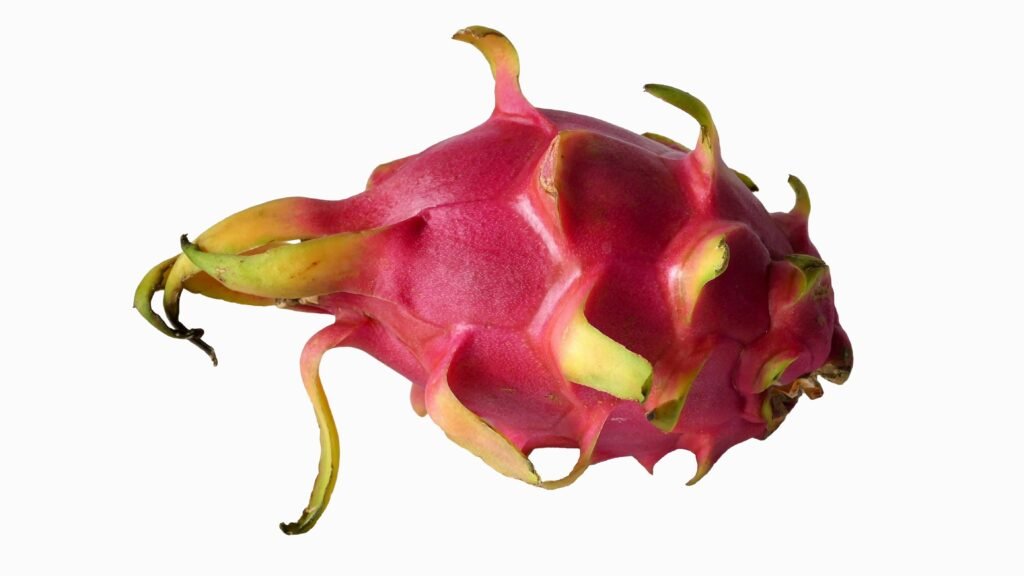Introduction to Dragon Fruit
Dragon fruit, also known as pitaya or pitahaya, is a tropical fruit that has garnered attention for its unique appearance and nutritional benefits. Originating from Central America, this exotic fruit is now cultivated in various tropical and subtropical regions around the globe, including Southeast Asia, Mexico, Israel, and parts of South America. The fruit itself is produced by several species of cacti, particularly those from the genus Hylocereus and Selenicereus.
The appearance of dragon fruit is one of its most striking features. It boasts vibrant colors, typically pink or yellow skin with green-tipped scales, reminiscent of a dragon’s skin, which is the inspiration behind its name. Inside, the flesh can be white, red, or even purple, speckled with tiny edible seeds similar to those found in kiwifruit. These visual characteristics make it not only a nutritional powerhouse but also a visually appealing addition to any dish.
There are three main varieties of dragon fruit commonly found in markets: Hylocereus undatus, which has white flesh and pink skin; Hylocereus costaricensis, with red flesh and pink skin; and Hylocereus megalanthus, which features white flesh and yellow skin. Each variety offers a slightly different flavor profile, ranging from mildly sweet to tangy, making it a versatile ingredient in various culinary applications.
The cultivation of dragon fruit has expanded significantly over the years due to its increasing popularity and demand. It thrives in warm climates with plenty of sunlight and well-drained soil. Farmers often use trellises to support the climbing nature of the cactus plants, ensuring optimal growth and fruit production. This expansion in cultivation has made dragon fruit more accessible to consumers worldwide, allowing more people to enjoy its various health benefits and unique taste.
Nutritional Profile of Dragon Fruit

Dragon fruit, also known as pitaya, is celebrated for its visually striking appearance and rich nutritional profile. This tropical fruit is a powerhouse of essential vitamins, minerals, and antioxidants, making it a valuable addition to any balanced diet. One of the standout nutrients in dragon fruit is vitamin C, a potent antioxidant that supports immune function, skin health, and collagen production. A single serving of dragon fruit can provide a significant portion of the daily recommended intake of vitamin C, helping to fortify the body’s defense mechanisms.
In addition to vitamin C, dragon fruit is an excellent source of dietary fiber. Fiber plays a crucial role in digestive health by promoting regular bowel movements and supporting a healthy gut microbiome. Consuming foods rich in fiber, like dragon fruit, can aid in weight management and reduce the risk of developing chronic diseases such as heart disease and type 2 diabetes.
Dragon fruit is also rich in magnesium, a mineral that is vital for many bodily functions, including muscle and nerve function, blood sugar control, and bone health. The fruit’s magnesium content contributes to its ability to support metabolic processes and maintain overall health. Moreover, dragon fruit contains iron, an essential component for the formation of red blood cells and the transportation of oxygen throughout the body. Including iron-rich foods in your diet can help prevent anemia and boost energy levels.
When considering the calorie content of dragon fruit, it is relatively low, making it an excellent choice for those looking to maintain or reduce their caloric intake while still obtaining essential nutrients. A typical serving of dragon fruit contains around 60 calories, making it a light yet nutrient-dense option for snacking or incorporating into meals.
Overall, the nutritional profile of dragon fruit highlights its role in promoting general health and well-being. Its combination of vitamins, minerals, and antioxidants makes it a valuable fruit for supporting various bodily functions and contributing to a balanced diet.
Health Benefits of Dragon Fruit
Dragon fruit, also known as pitaya, is not only a visually striking fruit but is also packed with numerous health benefits. One significant advantage is its potential to boost the immune system. Dragon fruit is rich in vitamin C, a potent antioxidant that helps strengthen the immune system by protecting the body against harmful pathogens. Additionally, the presence of other antioxidants such as betalains further enhances its ability to combat oxidative stress, thereby supporting overall immune health.
Improving digestion is another notable benefit of consuming dragon fruit. The fruit is high in dietary fiber, which plays a crucial role in maintaining a healthy digestive system. Fiber helps regulate bowel movements, preventing constipation and promoting a healthy gut environment. Studies have shown that a diet rich in fiber can reduce the risk of colon cancer and other gastrointestinal disorders, making dragon fruit a valuable addition to a balanced diet.
Dragon fruit also contributes to heart health. It contains flavonoids, which are known for their cardioprotective properties. These compounds help reduce the risk of heart disease by lowering bad cholesterol levels (LDL) and increasing good cholesterol levels (HDL). Additionally, the fruit’s high magnesium content is essential for maintaining a healthy heartbeat and supporting overall cardiovascular function.
Anti-inflammatory properties are another significant benefit of dragon fruit. The fruit’s antioxidants, vitamins, and minerals work together to reduce inflammation in the body. Chronic inflammation is a known risk factor for various diseases, including arthritis, diabetes, and heart disease. By incorporating dragon fruit into your diet, you can help mitigate these risks and promote a healthier inflammatory response.
Lastly, dragon fruit can aid in weight management. With its low calorie and high fiber content, it provides a feeling of fullness and helps control appetite. This makes it an excellent choice for those looking to maintain or lose weight. Furthermore, the fruit’s natural sugars offer a healthier alternative to processed sweets, contributing to better overall dietary habits.
In summary, dragon fruit is a nutritious tropical delight that offers a wide range of health benefits. From boosting the immune system and improving digestion to enhancing heart health and aiding in weight management, its inclusion in your diet can support overall well-being.
Dragon Fruit and Skin Health
Dragon fruit, known for its vibrant appearance and sweet taste, is more than just a delicious tropical treat. It also offers numerous benefits for skin health. When consumed regularly, dragon fruit can significantly hydrate the skin, thanks to its high water content. Additionally, this exotic fruit is rich in antioxidants, particularly vitamin C, which is essential for maintaining a youthful complexion and reducing signs of aging.
Consuming dragon fruit can help combat acne due to its anti-inflammatory properties. The presence of vitamin C not only boosts the immune system but also helps in the repair and regeneration of skin cells, keeping the skin clear and blemish-free. Moreover, the fruit’s fiber content aids in detoxification, which can further reduce acne outbreaks by eliminating toxins from the body.
Topical application of dragon fruit is equally beneficial. Its hydrating properties make it an excellent natural moisturizer. To create a simple yet effective DIY face mask, blend dragon fruit flesh into a smooth paste and apply it directly to the skin. Leave it on for 15-20 minutes before rinsing off with lukewarm water. This mask can help to rejuvenate the skin, imparting a fresh and radiant glow.
Another way to incorporate dragon fruit into your beauty regimen is by using it as a natural exfoliant. The small seeds of the fruit can act as gentle scrubbing agents. Mix dragon fruit pulp with a tablespoon of honey and a teaspoon of yogurt to create a nourishing exfoliating scrub. Gently massage the mixture onto your skin in circular motions and rinse off with water. This scrub helps to remove dead skin cells, unclog pores, and enhance overall skin texture.
In essence, dragon fruit offers a multitude of benefits for skin health, both when consumed and applied topically. Its hydrating, anti-inflammatory, and antioxidant properties make it a valuable addition to any beauty regimen, promoting a clear, youthful, and radiant complexion.
Culinary Uses of Dragon Fruit
Dragon fruit, with its vibrant appearance and unique flavor, offers a multitude of culinary possibilities. Its mildly sweet taste and crunchy texture make it a versatile ingredient in both sweet and savory dishes. When selecting dragon fruit, look for one that is bright in color and slightly soft to the touch, similar to selecting a ripe avocado. To prepare, simply cut the fruit in half and scoop out the flesh with a spoon, discarding the skin.
One of the most popular ways to enjoy dragon fruit is in smoothies. Its natural sweetness pairs well with other tropical fruits like mango, pineapple, and banana. For a refreshing smoothie, blend dragon fruit with coconut water, a squeeze of lime, and a handful of spinach for added nutrients. This vivid concoction is not only visually appealing but also packed with vitamins and antioxidants.
Dragon fruit also adds a delightful crunch to salads. Combine it with mixed greens, avocado, and a light vinaigrette for a refreshing and nutritious salad. For a more exotic twist, try a tropical fruit salad with dragon fruit, kiwi, strawberries, and a drizzle of honey. The contrasting textures and flavors create a harmonious and exciting dish.
In desserts, dragon fruit can be used to create visually stunning and delicious treats. Consider making a dragon fruit sorbet by pureeing the flesh and mixing it with a bit of sugar and lime juice before freezing. Alternatively, dragon fruit can be diced and used as a topping for yogurt, chia pudding, or even ice cream, adding a burst of color and flavor.
Surprisingly, dragon fruit can also be incorporated into savory dishes. Its subtle sweetness complements spicy and tangy flavors, making it an excellent addition to salsas or ceviche. Try mixing diced dragon fruit with tomatoes, onions, cilantro, and lime juice for a unique and refreshing salsa that pairs perfectly with grilled fish or chicken.
Experimenting with dragon fruit in your kitchen can lead to delightful culinary discoveries. Whether you’re blending it into a smoothie, tossing it into a salad, or incorporating it into a dessert or savory dish, dragon fruit’s versatility and nutritional benefits make it a fantastic ingredient to explore.
Growing Dragon Fruit at Home
Dragon fruit, also known as pitaya, is a strikingly exotic fruit that can be successfully cultivated at home with the right care and conditions. Whether you choose to grow dragon fruit outdoors or indoors, following specific guidelines will help ensure a thriving and productive plant.
To begin, select a healthy dragon fruit cutting or seed, although cuttings are generally recommended due to their faster growth and easier propagation. When planting outdoors, choose a location that receives full sunlight, as dragon fruit thrives in warm, sunny environments. Indoors, place the plant near a south-facing window or under grow lights to replicate similar conditions.
Dragon fruit plants require well-draining soil to prevent root rot. A sandy or loamy soil mix with a pH level between 6 and 7 is ideal. If planting in a pot, ensure it has ample drainage holes to avoid waterlogging. Fill the pot with a balanced cactus or succulent soil mix to provide the necessary nutrients and drainage.
Watering is crucial for the healthy growth of dragon fruit. The soil should remain consistently moist but not waterlogged. During the growing season, water the plant deeply once a week, allowing the topsoil to dry out between waterings. In cooler months, reduce the frequency to prevent overwatering. Mulching around the base of the plant can help retain moisture and regulate soil temperature.
Pest control is an essential aspect of dragon fruit cultivation. Common pests include aphids, mealybugs, and scale insects. Regularly inspect the plant and use organic insecticidal soap or neem oil to treat infestations. Additionally, ensuring good air circulation can help prevent fungal diseases.
For indoor gardeners, supporting the climbing nature of dragon fruit is vital. Use a trellis or stake to support the plant as it grows, encouraging it to climb and reducing the risk of damage. Pruning is also beneficial, as it helps maintain the plant’s shape and promotes better fruit production.
By following these guidelines, you can enjoy the rewarding experience of growing your own dragon fruit at home, whether in a garden or indoors. With proper care, your plant will not only add a touch of tropical beauty to your space but also provide delicious and nutritious fruits.
Dragon Fruit in Traditional Medicine
Dragon fruit, also known as pitaya, has long been revered in traditional medicine practices across various cultures. Its vibrant appearance and numerous health benefits have made it a staple in folk remedies, particularly in Southeast Asia and Central America, where the fruit is native. Traditional healers have utilized dragon fruit to address a variety of ailments, citing its cooling properties and nutrient-rich profile as key factors in its efficacy.
In traditional Chinese medicine, dragon fruit is believed to possess cooling (yin) properties, making it an ideal remedy for conditions related to heat, such as fever, inflammation, and skin irritations. It has been used to boost energy, improve digestion, and promote hydration due to its high water content. The seeds of dragon fruit are also thought to aid in bowel regularity, contributing to overall digestive health.
Similarly, in Mesoamerican cultures, dragon fruit has played a vital role in traditional health practices. Ancient Aztecs and Mayans consumed the fruit not only for its nutritional value but also for its purported medicinal benefits. Remedies often included dragon fruit to treat stomach ailments, boost immunity, and provide essential vitamins and minerals. The vibrant red and white flesh of the fruit was also used in various ceremonies, symbolizing health and prosperity.
Modern science is beginning to explore and validate these traditional claims. Research has shown that dragon fruit is rich in antioxidants, particularly vitamin C, which supports immune function and skin health. Its high fiber content aids in digestion and helps regulate blood sugar levels, while the presence of betalains has been linked to anti-inflammatory and anti-cancer properties. Additionally, dragon fruit contains prebiotics, which foster a healthy gut microbiome by promoting the growth of beneficial bacteria.
The historical anecdotes and traditional uses of dragon fruit underscore its long-standing significance in promoting health and well-being. As modern science continues to uncover the fruit’s myriad benefits, it becomes increasingly clear that dragon fruit is not just a delicious tropical delight but also a potent ally in both traditional and contemporary health practices.
Sustainability and Ethical Considerations
Dragon fruit farming, while gaining popularity globally, carries significant environmental implications that ought to be considered by conscientious consumers. As the demand for this nutritious tropical fruit increases, it becomes imperative to understand and promote sustainable agricultural practices that minimize environmental degradation. One of the primary sustainability practices in dragon fruit farming includes the use of organic farming methods. This involves avoiding harmful pesticides and synthetic fertilizers, which can lead to soil and water contamination. Instead, organic farming emphasizes the use of natural compost and biological pest control, fostering a healthier ecosystem.
Water management is another critical aspect of sustainable dragon fruit cultivation. Efficient irrigation techniques, such as drip irrigation, help in conserving water and ensuring that this precious resource is used judiciously. Given that dragon fruit is often grown in arid and semi-arid regions, responsible water usage becomes even more crucial. Furthermore, sustainable practices extend to preserving biodiversity. Intercropping dragon fruit with other plants can enhance soil fertility, reduce erosion, and support a diverse range of flora and fauna.
Supporting ethical growers is equally important in promoting sustainability. When purchasing dragon fruit, consumers should look for certifications that signify responsible farming practices. Certifications like Fair Trade or organic labels indicate that the fruit has been grown and harvested under conditions that prioritize environmental health and fair labor practices. These labels ensure that the farmers receive fair compensation and work in safe conditions, mitigating the risk of exploitation.
In addition to certifications, supporting local farmers and cooperatives can further enhance sustainability. Locally sourced dragon fruit not only reduces the carbon footprint associated with transportation but also supports community-based agriculture. By making informed choices and prioritizing sustainably and ethically sourced dragon fruit, consumers can contribute to the preservation of the environment and the well-being of farming communities.

